The 2012 MacBook Air (11 & 13-inch) Review
by Anand Lal Shimpi on July 16, 2012 12:53 PM EST- Posted in
- Apple
- Mac
- MacBook Air
- Laptops
- Notebooks
The Display
The MacBook Air is really Apple's mass-market notebook, and as such it's not going to be the target for a Retina Display upgrade, at least not this year. While technically feasible, my guess is a lack of supply kept a rMBA out of the cards for this year. There's also the matter of maintaining its thin profile and battery life in pursuit of a retina display.
The MacBook Air display continues to be good, and better than most, but no where near what the rMBP delivers and actually a step behind what the competition in the PC space has been cooking up.
If there was one clear trend at Computex this year it's towards IPS 1080p displays in Windows 8 notebooks. ASUS actually pre-empted all of the exciting announcements (rMBP included) with its Zenbook Prime, complete with 11 and 13-inch 1080p IPS displays. As the MacBook Air retains its TN display, for the first time we can actually say that ASUS' Ultrabook offers better viewing angles than the Air. The difference is quite noticeable:
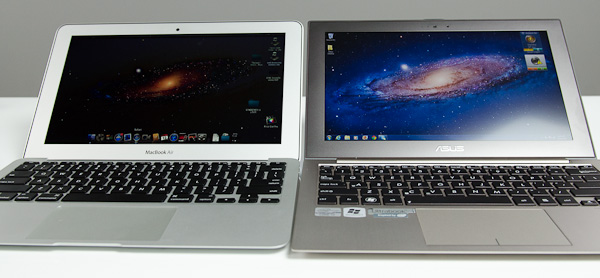
2012 MacBook Air (left) vs. 2012 ASUS Zenbook Prime (right)
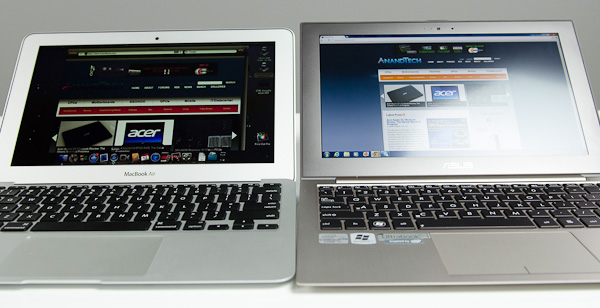
2012 MacBook Air (left) vs. 2012 ASUS Zenbook Prime (right)
ASUS also enjoys a resolution advantage, but it's not really high enough to make good use of integer DPI scaling (at 2x you get a UI sized for a 960 x 540 display). You get sharpness, and additional desktop area, but not the total package you get with the rMBP. There's no denying that what ASUS has done is better, it's just not perfect. And as Apple has shown us in the past, it's not fond of stopgap solutions.
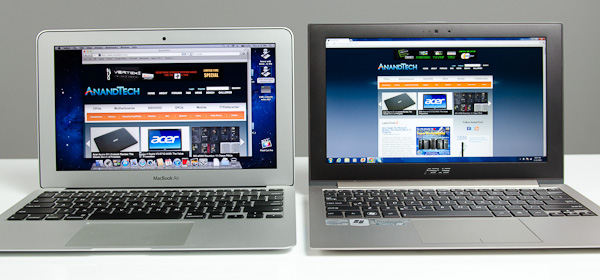
2012 MacBook Air (left) vs. 2012 ASUS Zenbook Prime (right)
Brightness, black levels, contrast, color accuracy and gamut haven't changed over the past year. The MacBook Air's panel remains one of the best non-IPS solutions on the market. The problem is that consumer insistence higher quality displays has pushed Apple's competitors to finally deliver more than TN at MacBook Air price points. Sooner rather than later, Apple will have to respond.
The Panel Lottery
Unlike in previous years, there appears to be three manufacturers supplying panels for the 2012 MacBook Air. LG Philips and Samsung return from before, but AUO now joins the fray. It's quite possible that Apple's volumes have grown large enough to justify adding a third supplier - a trend we may see increase in the future, and across more component categories.
As always, you can try to find out what panel is used in your MacBook Air by executing the following command in an OS X Terminal window:
ioreg -lw0 | grep IODisplayEDID | sed "/[^<]*</s///" | xxd -p -r | strings -6
The output will look something like this:

As long as Apple hasn't masked the data, the first line should be the part number of your display panel. The first one or two characters will tell you the manufacturer: LP for LG Philips, LT for Samsung and B for AUO. Anecdotally, LG and Samsung seem to be the most prevalent. In my personal experience with six 13-inch 2012 MacBook Airs and three 11-inch MacBook Airs, the breakdown was as follows:
13-inch $1499 - Samsung
13-inch $1499 - Samsung
13-inch $1499 - Samsung
13-inch $1499 - Samsung
13-inch $1499 - Samsung
13-inch $2199 - LG
11-inch $1099 - AUO
11-inch $1099 - AUO
11-inch $999 - Samsung
A thread over on Macrumors places the Samsung/LG split much closer to 50/50, however it's not clear if there's a higher incidence of LG panels in BTO or non-default configurations. We'd need many more samples to really get an idea for how all of this shapes up, so don't put too much faith in the results from my experience.
Apple does its best to ensure that all three panels deliver comparable performance, however there are differences. Let's first start with the numbers:
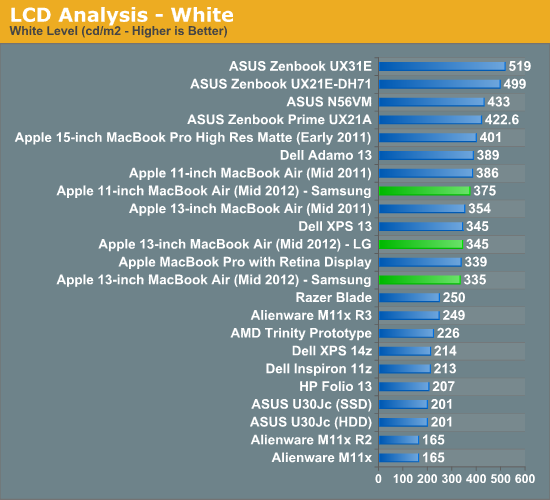
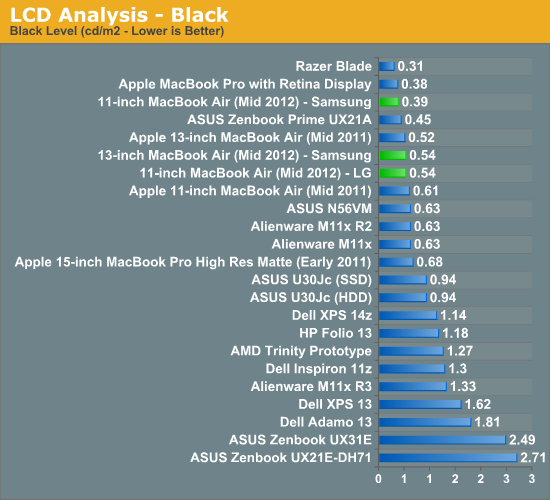
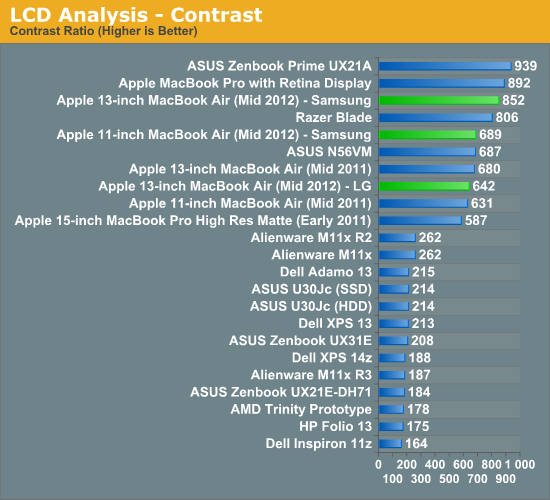
The 13-inch LG panel delivers tangibly worse black levels than the Samsung alternative. There's even a pretty dramatic difference in black levels between even the 11 and 13-inch Samsung panels. It's also possible that there's panel to panel variation at play here that would result in this sort of a difference.
The LG panel is a bit brighter, which helps it reach a decent contrast ratio but the 13-inch Samsung panel's low black levels give it an advantage. Interestingly enough, the 13-inch LG sample performed very similarly to the 11-inch Samsung. I really do wonder how much of this difference is just normal variance between panels.
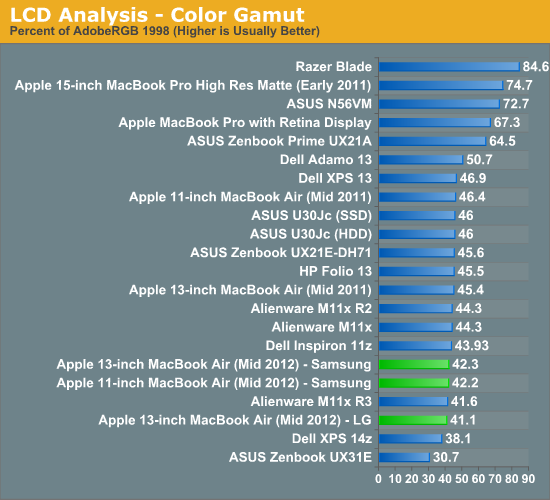
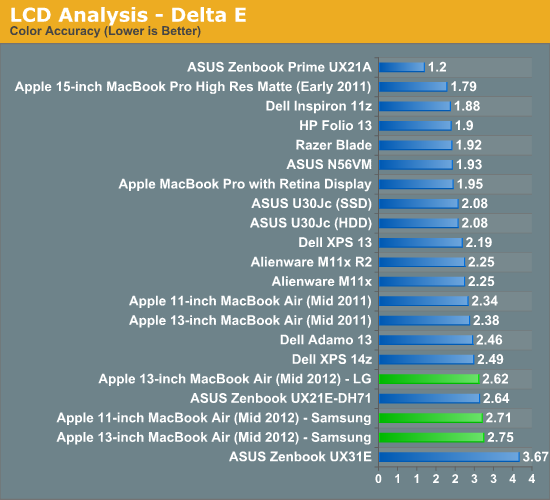
Color accuracy is slightly better on the LG panel, although it's not beyond the noticeable threshold. Color gamut is comparable between the displays.
Independently, neither the Samsung or LG panels is particularly bad to look at. These are still TN panels so you get poor vertical viewing angles, but the quality is still better than the cheaper TNs we often see used in less expensive notebooks. It's when you compare the two or you're used to one that you can really tell a difference: the Samsung panel, particularly when displaying black text on a white background, looks better than the LG.
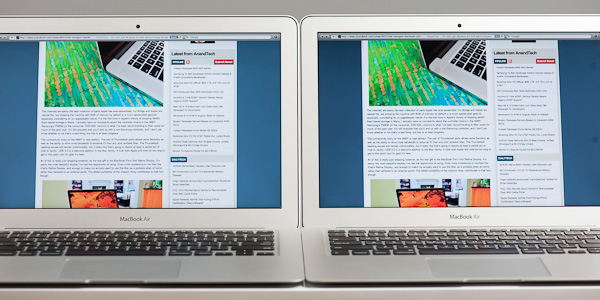
13-inch LG LP133WP1-TJA3 panel (left) vs. Samsung LTH133BT01A03 panel (right)
I had some friends over and tossed them a pair of 13-inch MBAs. One had the LG panel and one had the Samsung panel. They used the MBAs and swapped after a short while. Almost instantaneously they could tell the difference between the panels. Everyone significantly favored the Samsung.
I was actually a bit surprised how quickly they noticed the difference. With these type of things I always assume I'm just more sensitive than most, but in this case the difference was noticeable enough to pick out. Everyone added (and I agreed) that the difference was most pronounced because they were able to switch between two. In a vacuum each one seemed fine.
I tried my best to capture the difference between the two panels on camera. The easiest way to describe the difference is text on the Samsung panel just looks darker (mouse over the panel name in the table below):
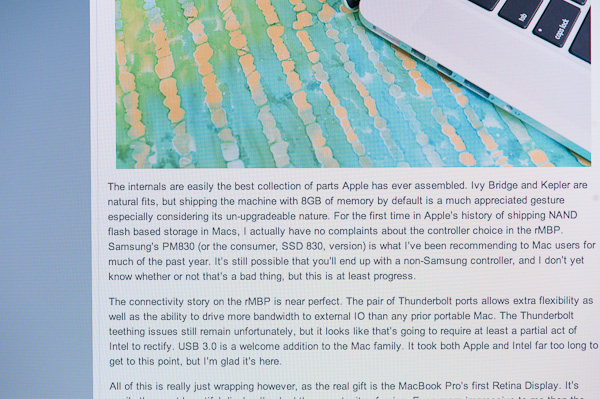
| LG LP133WP1-TJA3 | Samsung LTH133BT01A03 |
| original | original |
Just like last time, I believe the two panels behave differently in how they react to off-center viewing angles but I couldn't really capture the slight differences on camera. Although I didn't have an AUO equipped MBA on hand, the one I saw in an Apple store looked closer to the LG than the Samsung.
The good news is after a calibration pass using Color Eyes Display Pro, the difference between the two is significantly reduced - to the point where I can no longer tell the two apart:
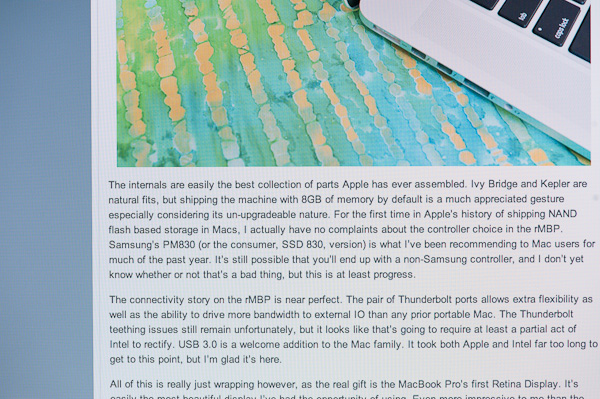
| LG LP133WP1-TJA3 | Samsung LTH133BT01A03 |
| original | original |
The obvious problem with this solution is you need access to a decent colorimeter or spectrophotometer and calibration software. There are some color profiles floating around the web that may help (I've uploaded mine for the LG here, Samsung here) but every panel is going to be at least somewhat different so this is still not perfect.
Subjectively, I'm fine with the LG panel, although I do like the look of the Samsung better. Both are a bit of a disappointment compared to what you get from the Retina Display in the MacBook Pro however. It's just presently what you give up for portability and cost.
To Make a Retina
The thing about the MacBook Air is that it's already quite minimized on the inside. The vast majority of the chassis is occupied by a battery, and there's no traditional HDD or optical drive to remove for additional space. Apple can't simply toss a much higher resolution panel on the system and call it a day, at least not without a tangible reduction in battery life.

13-inch MacBook Air (Mid 2012) - iFixit
Apple had to give the MacBook Pro with Retina Display a 95Wh battery (up from 77.5Wh) just to deliver similar battery life to the regular MacBook Pro. The higher resolution display requires a brighter backlight to push light through the panel and maintain comparable brightness levels.
The motherboard itself can stand to lose a single chip (the PCH) with the transition to Haswell, but that's not going to give us a ton of space either.
In the short term Apple could opt for a slightly thicker chassis (similar to what happened in the 3rd gen iPad) to accommodate a larger battery. Eventually the hope is that panel efficiency will increase to the point where we won't need significantly brighter backlights.


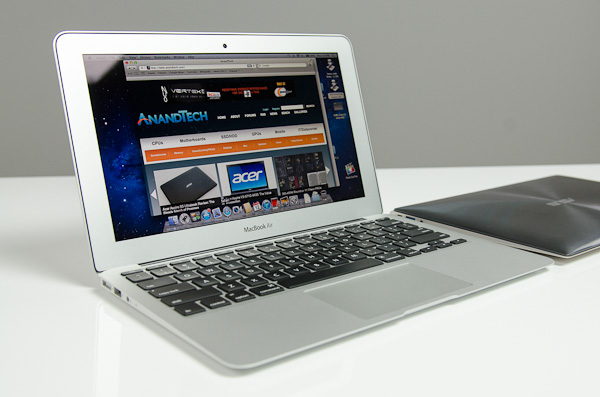








190 Comments
View All Comments
ShadeZeRO - Monday, July 16, 2012 - link
I'm curious as to why you haven't held the apple line to the normal scrutiny typically found in your other notebook reviews.I've noticed a certain level of bias on most review sites most likely caused by the sudden trend in popularity of Apple products.
If this was branded differently I'm positive the display for one would have been ridiculed as a poultry offering.
Overall a fine review, it's not on the level of a gizmodo/engadget/etc apple circle jerk so I still respect it.
/rant
KoolAidMan1 - Tuesday, July 17, 2012 - link
He criticized the display and compared it unfavorably against other ultrabooks that use IPS panels. It is one of the few points of criticism, but its there. Is your problem that he doesn't say that the MBA is a complete piece of trash?Anand gave a very well balanced review as per usual.
Super56K - Tuesday, July 17, 2012 - link
I would gladly take a 1440x900 TN display like the Air's in a 13" Sandy/Ivy Bridge Windows laptop.notposting - Tuesday, July 17, 2012 - link
Paltry offering.Unless they are offering up some turkeys, ducks, and chickens for sacrifice.
Alameda - Tuesday, July 17, 2012 - link
First of all, Anand, I want to tell you that you've once again written up an excellent review, and I'm very impressed with your thoroughness and clarity. I just purchased a 2011 MBA, so of course I read your review to justify that I made the right decision. While I understand the need for benchmarks and the real-world tests such as Photoshop and so forth, I think most people do not use their computers the way your tests imply.In my daily use, the performance bottleneck I experience is when making a Time Machine backup, which the new machines should improve upon -- USB 2.0 is very slow, and Thunderbolt drives are too expensive. USB 3.0 is the right solution for most users. I would also like to see networking tests. This machine needs wifi to work, and there's a lot of performance variance from one 802.11n to another. Last, sincecthe RAM is soldered, adding guidance about memory use would be useful. On my MBA, if I open all of my applications at once (except VMWare), I use less than 2 of my 4 GB of RAM. So it seems to me that 8+ GB only matters if you have a specific power-user need, particularly in a simultaneous Mac/Windows setup, but for most users, 4 GB and the stock CPU exceeds what you can use.
I personally think these sorts of real world tests would make your reviews better reflect what most users actually do. I also feel that many people want to make excuses for taxing a machine to its limits, but we simply don't have such issues in actual use.
name99 - Tuesday, July 17, 2012 - link
Basically 2GiB is tight for pretty much any OSX user nowadays, but swapping on even the 2011 SSDs is fast enough that you don't really notice it. You can live it, but you will notice occasional pauses.You want 4GiB if you tend to keep a lot of browser windows open. Safari is a pig in this respect (hopefully improved somewhat in ML) and Chrome is not that much better.
My collection of always-running apps is Finder, Mail, iChat, Skype, iTunes and Safari; something like this is, I think, pretty standard across most users. That, with 20 or so browser windows, will fit OK in 4GiB, but will start obviously paging if you add a few more apps, eg throw in Word or Excel or an Adobe app.
(
Where does it go?
Essentially the OS is using about 500MB for misc [process management, memory management, network buffers, that sort of thing] and about 1GB for file buffers of various sorts. Of the 2.5 GB that's left, the worst offenders:
WebProcess, essentially the guts of Safari, is currently using 1.2GB which is pathetic, the actual Safari process, basically UI, is using 200MB, also pathetic, and iTunes is using 530 MB --- TRULY pathetic, but what else would you expect from, iTunes, apparently the team to which Apple retires their most doddering and incompetent programmers.
)
For most people, however, I'd recommend 8GiB purely because
- it's not that much more in cost.
- you may not need it now, but you're future-proofing yourself since most normal people use their laptops for at least 3yrs before replacing them
- the extra retail value when you do retire it is probably worth more than the extra cost now --- just think of the comparable desirability today of a 2GB vs a 4GB 2010 MBA.
Freakie - Tuesday, July 17, 2012 - link
I'd definitely agree with you that 8GB really should be what most people get. Even though they wont know or understand the difference, it makes a difference in how much they will enjoy any computer, PC or Mac. You just never know when someone will do something that eats up a ton of RAM, whether it be running a game without closing their browser, or opening up 100+ browser tabs, 4 word documents, and 4 excel books (my girlfriend does that a lot, and it makes her 8GB rather unhappy).And if you have an Windows computer with a 64bit install, more RAM is even more important for getting the best possible experience. While I can't say while OSX seems to have such RAM hungry programs that don't offer performance gains for so much usage, I can say that I put specific 64bit programs on my Windows laptop knowing that they will perform better and be able to use more RAM and use it more effectively. My 64bit Firefox browser is a great example of that. I don't mind it using 2-3GB of RAM because I have a crap ton of stuff open, multiple flash based videos, a flash game, ect... because it's just a nice experience. Not to mention this 64bit version is way faster than the regular one :P Regular users could be having these nice experiences too if the general consensus on what a good amount of RAM is would increase.
On a side note... I'm thinking of going up to 16GB on my laptop, maybe 24GB... Just because I'm greedy :P Might even go the full 32GB and put a RAMdisk... who knows! So many possibilities when you have MORE RAM!
phillyry - Tuesday, March 26, 2013 - link
'Future proofing' = illusionHere's your future proofing. Buy what you need now of will likely need in the near future and save your pennies (or, in this case hundreds of dollars with of upgrades) for your next upgrade. And by upgrade, I mean your next laptop or whatever the hell else you want to do wig your money. Why leave an extra $100 lying inside a computer chassis in the shape of some soldered on RAM, if you can keep that money in your bank account and buy whatever else you want or, maybe even, actually need with it.
Really, the upgrades should only be for the hardcore users and should not be a concern for most people.
name99 - Tuesday, July 17, 2012 - link
What sort of compression does Sandforce use?More specifically, I imagine that within a file they use some sort of LZ variant --- it's easy, it's known to work well for this sort of problem, and there's hardware to handle it.
More interesting is the question of what sort of cross-file de-duplication they use. The obvious thing would be some sort of hash of each 4kiB block to something like a 128b signature, then compare each incoming block to that map. But that would require an in-memory table of hashes that would be of order 256MiB in size for a 64GB drive (and twice that for a 128GB drive), which, while obviously technically possible, doesn't seem to match their actual hardware setup. You could drop the hash to 64b, at the cost of more frequent collisions (and thus having to waste time reading the drive to compare with the incoming block) and that would halve your table size --- again possible, but still looking like it uses more RAM than they have available.
So what's the deal? They don't actually do cross block de-dup? They do it in some fashion (eg using larger blocks than 4kiB) which, while it works, is not as optimal for small files?
desmoboy - Tuesday, July 17, 2012 - link
Excellent Review Anand. Do you have a explanation why the 13" MBA i7 is 28 sec slower in the iMovie '11 (Import + Optimize) benchmark than the i5 version? Seems bit strange when the i7 scores higher on every other of your benchmarks (as one would expect)